Nitric Acid, a hotplate and a power transistor
Sy is going to love this one! So I was reading around on the internet about how to detect fake transistors. It seemed like in general the fake transistors use an impossibly small die; usually around 3 mm2 where the authentic is around 25mm2. It seemed like the common way to open the transistor up was to use mechanical force and take a look at the pad for the transitor. Sometimes the die would stick to the metal side but usually it would either fracture or all you would see was the bonding material.
I came across a site that mentioned using 70% Nitric Acid and heat. Interesting...*taps fingers together like an evil villain*. I have 70% Nitric Acid, I have a couple transistors that are dead, I have a chemical hot-plate and I have a fume hood to do this in. 😀
Before we go ANY further, I am a trained inorganic/nanotech chemist. I know what I'm doing. If you don't this stuff could easily injure you or worse. The nitric acid off-gases poisonous nitric oxides as it reacts. It sputters mixtures of acid and epoxy. Let alone the acid itself, which is highly concentrated and a huge risk to use. I did this in a chemical fume hood, with the glass down to protect my face. I also had on lab coat, gloves, safety glasses etc. If you don't have the proper training to do this, DON'T!
So I get set up, turn the hot plate on, let the transistors sit on the hot-plate for about 10 min (turns out to be way excessive). Put a few drops of concentrated HNO3 and it starts bubbling and sputtering but not much change. I keep trying and after about 20 drops I can see some changes.
As I worked on them I realized a few things:
All being said, it took a while to do (maybe 20-30 min) and around 20mL of HNO3 to eat through the epoxy on the transistor.
The end result? The die appears to be exactly 25mm2 so its not likely a fake. It also shares a lot of other traits with some of the pics I have seen of TIP35C and TIP36C broken open. Unfortunately, I didn't get all the way through the second one before I ran out of acid.
Anyways I think it made for some cool pics.
You can clearly see the structure of the die and the bond wires. I eventually mechanically broke off some of the epoxy to show that the metal base and the middle pin are all one continuous piece. In the third from last picture how it was preferentially eating the copper at this point (even eating it out from underneath the transistor die. Also, you can see the one which wasn't finished. The lead wires are just starting to show. Lastly, you can see how harsh the reaction was because the metal parts all used to be shiny.
Sy is going to love this one! So I was reading around on the internet about how to detect fake transistors. It seemed like in general the fake transistors use an impossibly small die; usually around 3 mm2 where the authentic is around 25mm2. It seemed like the common way to open the transistor up was to use mechanical force and take a look at the pad for the transitor. Sometimes the die would stick to the metal side but usually it would either fracture or all you would see was the bonding material.
I came across a site that mentioned using 70% Nitric Acid and heat. Interesting...*taps fingers together like an evil villain*. I have 70% Nitric Acid, I have a couple transistors that are dead, I have a chemical hot-plate and I have a fume hood to do this in. 😀
Before we go ANY further, I am a trained inorganic/nanotech chemist. I know what I'm doing. If you don't this stuff could easily injure you or worse. The nitric acid off-gases poisonous nitric oxides as it reacts. It sputters mixtures of acid and epoxy. Let alone the acid itself, which is highly concentrated and a huge risk to use. I did this in a chemical fume hood, with the glass down to protect my face. I also had on lab coat, gloves, safety glasses etc. If you don't have the proper training to do this, DON'T!
So I get set up, turn the hot plate on, let the transistors sit on the hot-plate for about 10 min (turns out to be way excessive). Put a few drops of concentrated HNO3 and it starts bubbling and sputtering but not much change. I keep trying and after about 20 drops I can see some changes.
As I worked on them I realized a few things:
- Cover your hot plate in aluminum foil, it gets messy.
- If it is bubbling rapidly you are just wasting acid, it should bubble lightly.
- Add a couple drops, allow it to bubble up and reduce then add another for about 5 total drops.
- After 5 drops let it bubble almost until evaporated you will see the liquid get dark brown and thicker.
- Wipe it off with a paper towel at this point.
- Repeat
All being said, it took a while to do (maybe 20-30 min) and around 20mL of HNO3 to eat through the epoxy on the transistor.
The end result? The die appears to be exactly 25mm2 so its not likely a fake. It also shares a lot of other traits with some of the pics I have seen of TIP35C and TIP36C broken open. Unfortunately, I didn't get all the way through the second one before I ran out of acid.
Anyways I think it made for some cool pics.
You can clearly see the structure of the die and the bond wires. I eventually mechanically broke off some of the epoxy to show that the metal base and the middle pin are all one continuous piece. In the third from last picture how it was preferentially eating the copper at this point (even eating it out from underneath the transistor die. Also, you can see the one which wasn't finished. The lead wires are just starting to show. Lastly, you can see how harsh the reaction was because the metal parts all used to be shiny.
Attachments
-
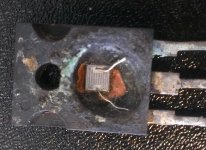 Transistor 1.jpg167.3 KB · Views: 246
Transistor 1.jpg167.3 KB · Views: 246 -
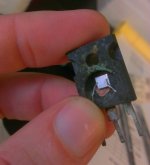 Transistor 2.jpg66.9 KB · Views: 267
Transistor 2.jpg66.9 KB · Views: 267 -
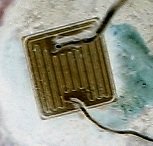 Transistor 3.jpg17 KB · Views: 233
Transistor 3.jpg17 KB · Views: 233 -
 Transistor 4.jpg76.2 KB · Views: 231
Transistor 4.jpg76.2 KB · Views: 231 -
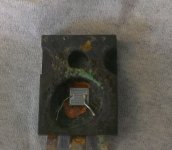 Transistor 5.jpg120.8 KB · Views: 238
Transistor 5.jpg120.8 KB · Views: 238 -
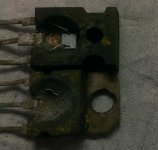 Transistor 6.jpg180.4 KB · Views: 114
Transistor 6.jpg180.4 KB · Views: 114 -
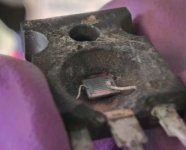 Transistor 7.jpg83.5 KB · Views: 109
Transistor 7.jpg83.5 KB · Views: 109 -
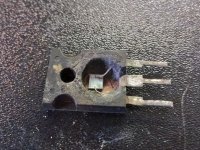 Transistor 8.jpg278.7 KB · Views: 112
Transistor 8.jpg278.7 KB · Views: 112 -
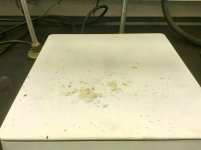 My Hotplate.jpg121.2 KB · Views: 106
My Hotplate.jpg121.2 KB · Views: 106
Last edited:
Ahh,very nice.
Not long ago I saw a video on YT about this,it might be interesting.
Decapping ICs (removing epoxy packaging from chips to expose the dies) - YouTube
Not long ago I saw a video on YT about this,it might be interesting.
Decapping ICs (removing epoxy packaging from chips to expose the dies) - YouTube
Nice; It made for some great pics. I guess since you said to cover the hot plate with Al foil that HNO3 doesn't attack aluminum as quickly as other materials? The bond wires are also probably aluminum with a but of Si so I guess that's why they'd survive for a while.
Very revealing.
Matt
Very revealing.
Matt
Nice; It made for some great pics. I guess since you said to cover the hot plate with Al foil that HNO3 doesn't attack aluminum as quickly as other materials? The bond wires are also probably aluminum with a but of Si so I guess that's why they'd survive for a while.
Very revealing.
Matt
Aluminum is relatively resilient to strong oxidizing acids because they form a protective oxide layer. Though mixing sulfuric and nitric together will dissolve aluminum quite nicely. Yeah the bond wires are likely aluminum, the die itself of course is likely doped Si which will NOT dissolve in nitric acid.
I kinda feel like this belongs more in the general chat or off topic tpye of area then in the parts section.
Last edited:
Super cool. Won't be doing it, no chemical hood or nitric acid, but nice to know it is possible. Thanks for putting it here, I don't read chat.
When I was in college (way back when), some students in the dorm were sawing open the metal cases on transistors and replacing blown bond wires people had shorted on their stereos. Power transistors were $12 apiece then, when minimum wage campus jobs paid $1.60 an hour.
When I was in college (way back when), some students in the dorm were sawing open the metal cases on transistors and replacing blown bond wires people had shorted on their stereos. Power transistors were $12 apiece then, when minimum wage campus jobs paid $1.60 an hour.
So we got a 4L bottle of conc nitric in. So up first for today's teardown we have an old Harris RFP12N18. It's a rather unremarkable 180V 12A N-channel Power MOSFET
So as usual heat the mosfet up and start adding acid.
After a while of adding acid and wiping we can see the bond wires (plus lost a leg)
At this point, too much copper was present. The copper catalyzed the break down of the nitric acid. So more drastic measures were needed.
Yep, I dropped it directly into boiling nitric acid. The brown fumes being generated are highly toxic and can kill you. I did this in a fume hood for safety.
After a minute or two the tab is almost gone. Followed by a bit more and start to see the die underneath.
Note: The copper nitric solution generated is highly environmentally toxic. It was disposed of in the appropriate acid waste.
Anyways, I threw it back in the boiling acid and at last we get this:
The left wire is the source, the right the gate. While the backside is the drain. I'm not sure what the purpose of the lines on the back are. In general, not as interesting as the bjt.
An externally hosted image should be here but it was not working when we last tested it.
So as usual heat the mosfet up and start adding acid.
An externally hosted image should be here but it was not working when we last tested it.
After a while of adding acid and wiping we can see the bond wires (plus lost a leg)
An externally hosted image should be here but it was not working when we last tested it.
At this point, too much copper was present. The copper catalyzed the break down of the nitric acid. So more drastic measures were needed.
An externally hosted image should be here but it was not working when we last tested it.
Yep, I dropped it directly into boiling nitric acid. The brown fumes being generated are highly toxic and can kill you. I did this in a fume hood for safety.
After a minute or two the tab is almost gone. Followed by a bit more and start to see the die underneath.
An externally hosted image should be here but it was not working when we last tested it.
An externally hosted image should be here but it was not working when we last tested it.
Note: The copper nitric solution generated is highly environmentally toxic. It was disposed of in the appropriate acid waste.
Anyways, I threw it back in the boiling acid and at last we get this:
An externally hosted image should be here but it was not working when we last tested it.
An externally hosted image should be here but it was not working when we last tested it.
The left wire is the source, the right the gate. While the backside is the drain. I'm not sure what the purpose of the lines on the back are. In general, not as interesting as the bjt.
Last edited:
Having seen how well doing it in nitric worked. Time for our next test subject! An old 74HC14AP.
The case on this dissolved rapidly and became very soft and chunky surprisingly quickly. After about a minute, you can already see the bond wires plus the legs are gone:
Unfortunately the bond wires are copper. Plus the die is ridiculously small. Maybe 1-2mm per side. By the time it's done we are left with this tiny gold colored die. Too small to photograph using my cellphone and to tiny to make out any surface detail. Kinda disappointing.
You can really see how much room is wasted in a DIP package. My guess is around 95% of the space is wasted.
An externally hosted image should be here but it was not working when we last tested it.
The case on this dissolved rapidly and became very soft and chunky surprisingly quickly. After about a minute, you can already see the bond wires plus the legs are gone:
An externally hosted image should be here but it was not working when we last tested it.
Unfortunately the bond wires are copper. Plus the die is ridiculously small. Maybe 1-2mm per side. By the time it's done we are left with this tiny gold colored die. Too small to photograph using my cellphone and to tiny to make out any surface detail. Kinda disappointing.
An externally hosted image should be here but it was not working when we last tested it.
An externally hosted image should be here but it was not working when we last tested it.
You can really see how much room is wasted in a DIP package. My guess is around 95% of the space is wasted.
- Status
- Not open for further replies.
- Home
- Design & Build
- Parts
- Nitric Acid and a hotplate